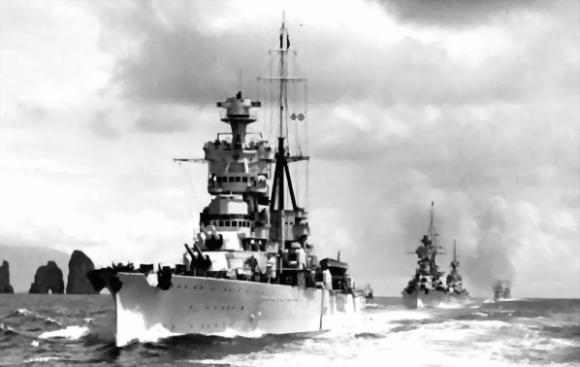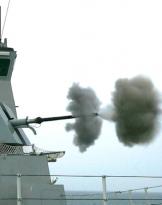The units assigned to the operation Vigorous they departed staggered with the intention of reuniting at sea before proceeding to Malta; first to move was section 11C, which sailed from Port Said on 11 June with four merchantmen escorted by the cruiser HMS Coventry (following photo) and by eight destroyers: the convoy pointed ostentatiously towards the west trying to appear as a resupply mission headed for Tobruch, with the aim of diverting the adversaries and of luring the Italian fleet out of its bases to subject it to air and cause them to consume fuel unnecessarily.
In the afternoon of 12 June, the section was identified by Axis scouts, just shortly after having reversed course to head towards the meeting area with the rest of the convoy; that evening a formation of German Ju 88 bombers attacked the British units at around 21:00 and badly damaged the steamer City of Calcutta, forcing him to take refuge in Tobruch, under the escort of the destroyers HMS Exmoor and HMS Croome.
The section then rejoined the rest of the convoy on the morning of 13 June off Alexandria, then proceeding to Malta. Again on 13 June the convoy suffered air attacks while taking the so-called Bomb Alley (“Vicolo delle bombe”), the stretch of sea south of Crete placed within the range of Axis bombers: the cargo Elizabeth Bakke she suffered minor damage but, as she could no longer keep up with the speed of the rest of the convoy, was ordered back to Alexandria.
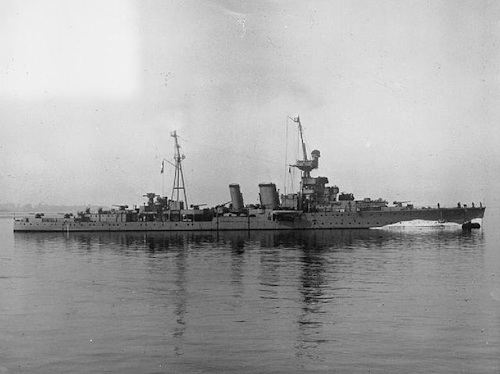 During the night between 13 and 14 June the bad weather conditions forced Rear Admiral Vian to deprive himself of the four motor gunboats attached to the convoy, which were no longer able to sail: three of them managed to take refuge in Alessandria but the fourth, the MTB 259, was shipwrecked and sank; the corvette Erica accused problems with the propulsion system and was then ordered to return to port at Marsa Matruh.
During the night between 13 and 14 June the bad weather conditions forced Rear Admiral Vian to deprive himself of the four motor gunboats attached to the convoy, which were no longer able to sail: three of them managed to take refuge in Alessandria but the fourth, the MTB 259, was shipwrecked and sank; the corvette Erica accused problems with the propulsion system and was then ordered to return to port at Marsa Matruh.
On the morning of the 14th the convoy suffered further losses: the steamer Aagtekirk proved unable to keep pace with other units and was ordered to head for Tobruch under destroyer escort HMS Tetcott and the corvette Primula, but around 08:00 it was reached by German bombers and set on fire, finally ending up stranded in front of Tobruch where it sank; in the afternoon Axis planes hit the freighter potaro which, however, was able to carry on while the Bhutan it was hit by Captain Mario Reghini's CANT Z.1007 and, badly damaged, sank later. Her crew and passengers were later recovered by salvage units Antwerp e Mechelen (two Great Eastern Railway passenger ships of about 3.000 t converted to troop transports), which then headed for Tobruch. While the air attacks were still underway, around 18:45 Vian received another bad news: aerial reconnaissance aircraft reported that the Italian fleet from Taranto was leaving the sea, aimed at cutting off the route of the British convoy.
The sinking of the Trento
With the position and route of the convoy now clear, in the late afternoon of 14 June Supermarina ordered the Italian battle squadron to leave the Taranto base with the aim of intercepting the British units the following morning: under the orders of the squadron admiral Angelo Iachino the battleships set sail Littorio e Vittorio Veneto, heavy cruisers Trento (photo opening) e Gorizia and light cruisers Giuseppe Garibaldi ed Emanuele Filiberto Duke of Aosta, escorted by twelve destroyers.
 For the first time in its history, the Italian fleet put to sea relying on the support of a radar system: the destroyer Legionary (photo) in fact, he embarked a German aircraft Fu.Mo. 24/40Ggl "De.Te." (Dezimetre Telegraphie) which, although useful for coordinating the squadron's night maneuvers and spotting enemy air attacks with a certain advance, provided a relative performance as it was disturbed by the echoes generated by the many nearby boats and because, installed as it was on a single unit , his reports arrived late to the other ships.
For the first time in its history, the Italian fleet put to sea relying on the support of a radar system: the destroyer Legionary (photo) in fact, he embarked a German aircraft Fu.Mo. 24/40Ggl "De.Te." (Dezimetre Telegraphie) which, although useful for coordinating the squadron's night maneuvers and spotting enemy air attacks with a certain advance, provided a relative performance as it was disturbed by the echoes generated by the many nearby boats and because, installed as it was on a single unit , his reports arrived late to the other ships.
The Italian squadron was sighted by British aerial scouts shortly after its departure, and followed constantly throughout its journey. Just before dawn on 15 June, the first attack by aircraft based on Malta arrived: nine torpedo bombers Bristol Beaufort at about 05:15 they attacked the Italian cruiser squadron, which sailed at the head of the formation; the cruisers Gorizia e Garibaldi they avoided the torpedoes aimed at them with a series of violent turns, but the cruiser Trento it was hit squarely on the starboard side by a torpedo bomber which had managed to get within only 200 meters of the hull. The torpedo cashed by the Trento opened a vast gash in the hull causing the flooding of the bow boiler room and a fire on board, while the infiltration of sea water also reached the stern boiler room causing it to shut down; completely immobilized the Trento it was therefore left behind by Iachino with the escort of the three destroyers Antonio Pigafetta, Lightning e Black shirt.
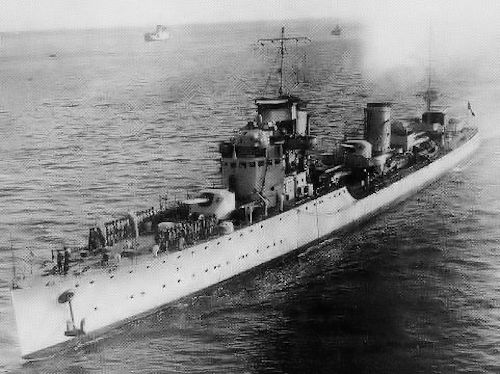 Around 09:00 the fire on board was extinguished and operations began so that the cruiser could be towed by the destroyer Pigafetta (photo), while a salvage tug headed to the area to bring help.
Around 09:00 the fire on board was extinguished and operations began so that the cruiser could be towed by the destroyer Pigafetta (photo), while a salvage tug headed to the area to bring help.
However, the high column of smoke raised by the fire had attracted the attention of three British submarines crossing in the Ionian Sea: the first to arrive at the site of the torpedoing was the HMS P35, which had recovered a few hours earlier from a failed attack against the battleship Littorio; at 09:10 the British boat launched two torpedoes at the immobile cruiser, hitting her bow under the second gun tower and causing the explosion of an ammunition depot. The ship listed to port and sank rapidly by the bow, while the three destroyers tried in vain to attack the British submarine; of the 1.151 crew, 602 were recovered by Italian units, many of them wounded. The commander of the Trento vessel captain Stanislao Esposito and the commander in 2nd frigate captain Carlo Cacherano d'Osasco, both perished in the sinking, were respectively decorated with a gold medal for military valor in memory of the first and a war cross to military valor the second.
Informed of the exit into the sea of the Italian fleet, around 01:45 on 15 June, Vian decided to temporarily reverse the route of the convoy in order to delay the meeting with the enemy units, thus allowing the air attacks and submarines to reduce them the number and perhaps to induce them to withdraw; the convoy had been constantly followed by Axis night scouts who signaled their position by means of flares, and as they proceeded with the course reversal some units found themselves isolated, being immediately attacked by a group of German torpedo boats about 90 miles to the north -east of Derna: motor torpedo boat S 56 managed to place a torpedo on the light cruiser HMS Newcastle which reported a large gash on the starboard side with numerous structural and engine damages, but without accusing losses among the crew. Two hours later a second group of motor torpedo boats attacked the escort units which surrounded the injured Newcastle and the destroyer HMS Hasty was hit by a torpedo from S 55 on the starboard side, causing thirteen deaths among the crew as well as serious damage to the keel and a large fire on board; the wreck of the unit was later sunk by the destroyer HMS Hotspur.
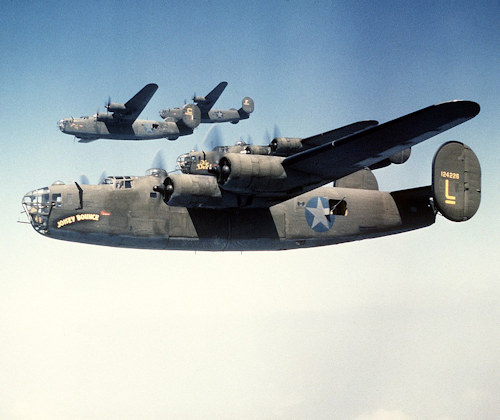
After being informed of the torpedoing of the Trento, around 07:00 Rear Admiral Vian ordered the convoy to retrace its steps and head for Malta, thinking that the Italian squadron would not expose itself further; instead Iachino continued to lead his battleships to meet the British units.
Around 09:00 the Italian fleet was attacked three times by British torpedo bombers, who tried in every way to slow it down; while all the anti-aircraft was engaged to repel the torpedo bombers, the Italian units were attacked by a squadron of US B-24 bombers (photo) which, completely unexpectedly and thanks to the sophisticated Norden targeting system, dropped their bombs from high altitude: the bombs exploded very close to the Italian ships, but only the battleship Littorio was hit by a bomb on the forward tower, without sustaining serious damage but accusing the death of a sailor and the wounding of another twelve. The B-24s then attempted to reach Malta, but were intercepted by German Messerschmitt Bf 109 fighters which shot down two of them, prompting the two surviving aircraft to take refuge in Africa. Informed by the scouts that the Italian fleet continued to proceed towards its ships, at 09:40 Vian again gave the order to the convoy to reverse course and head east, in order to escape the enemy units. Even the British units were soon targeted by Axis aircraft: the HMS cruisers Birmingham ed Arethusa they were lightly damaged by nearby shells but were able to continue underway.
Around 14:00 Iachino received the order from Supermarina to desist from pursuing the British units, now too far away; however, the Italian ships were ordered to stay and cross off the western coast of Greece, in the event that the British once again decided to reverse course. Vian's units were at that time still repeatedly attacked by Axis aircraft: at about 14:15 the destroyer HMS airedale came under fire from a formation of Junkers Ju 87 dive bombers He knocks Germans, being hit in full by two bombs which caused the detonation of an ammunition depot. The wreck was later sunk by the destroyer HMS Aldenham after evacuating the 133 surviving crew.
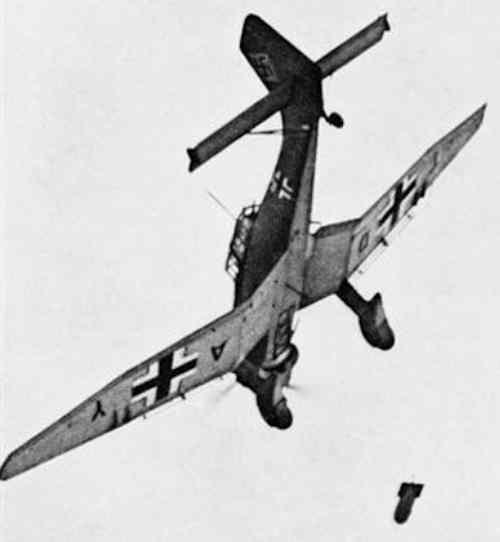 - He knocks they also raged repeatedly against the fake battleship Centurion, mistaken for a real battle unit: the ship cashed a bomb but was able to continue; around 17:30 instead four Italian SM79s attacked the Australian destroyer HMAS Nestor, causing heavy damage and forcing the fighter HMS Javelins to take him in tow. Shortly afterwards the four torpedo bombers, part of the 41st land bombardment wing, were intercepted by some Curtiss P-40 fighters which shot down one of them, with the entire crew lost at sea.
- He knocks they also raged repeatedly against the fake battleship Centurion, mistaken for a real battle unit: the ship cashed a bomb but was able to continue; around 17:30 instead four Italian SM79s attacked the Australian destroyer HMAS Nestor, causing heavy damage and forcing the fighter HMS Javelins to take him in tow. Shortly afterwards the four torpedo bombers, part of the 41st land bombardment wing, were intercepted by some Curtiss P-40 fighters which shot down one of them, with the entire crew lost at sea.
The Axis aircraft left the British formation about 19:00, and by then Vian received word from Vice-Admiral Harwood in Alexandria that the Italian units had given up the pursuit, and that the convoy could resume its course for Malta; However, Vian reported that his units were low on fuel (especially the destroyers) and above all that the ammunition stocks were reduced to 30% of the endowment: therefore the British commander decided to bring his surviving units back to port.
The Italian units remained to cross in vain off the Greek coasts until sunset, when Iachino ordered the return to Taranto: around 23 pm, taking advantage of the flare light, a formation of British torpedo bombers launched a last attack against the Italian ships, managing to hit the bow of the Littorio with a torpedo; however, the battleship reported little damage, and she was able to return to Taranto without major problems.
The British convoy suffered further losses that night: at about 20:00 the light cruiser HMS Hermione was hit on her starboard side by a torpedo from the German submarine U-205 north of Sollum, sinking within twenty minutes with the loss of 87 of her crew.
The last British loss was the destroyer Nestor: still towed by the Javelin and escorted by two other destroyers, it had remained very late compared to the convoy while trying in every way to return to Alexandria, very bowed due to the large quantity of water embarked; as daybreak approached, and many miles still to go under threat of attack from the air, the crew was evacuated and at 07 the destroyer was scuttled with depth charges by the Javelins 115 miles N.E. of Tobruch.
The convoy then reached Alexandria on the evening of 17 June, ending the mission.
Consequences
Of the seventeen steamers and tankers that set sail for Malta, only two managed to reach their destination, one of which was damaged: with the addition of the cargo that arrived on the minelayer Welsman, the supplies thus transported were considered sufficient to extend the island's resistance by only eight weeks.
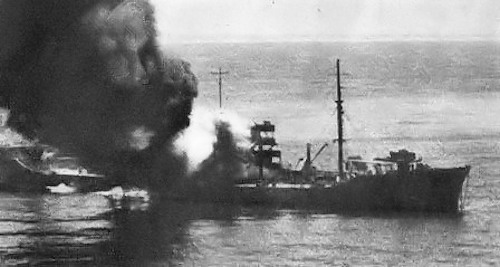 This was achieved at great cost to the British naval forces: losses included one light cruiser (Hermione), five destroyers (Hasty, Nestor, airedale, Bedouin e kujawiak), five loaded steamers, a tanker, a motor gunboat and a drifter; the cruisers Liverpool e Newcastle and the destroyers Partridge, Badsworth e Matchless they reported heavy damage which forced them to remain out of service for several months, while lighter damage was reported by the cruisers Cairo, Arethusa e Birmingham, together with a minesweeper and three freighters. Then there was the loss of thirty aircraft. The loss of the tanker Kentucky (photo) and its 10.000 t of fuel was a serious problem for the island's air force, which was short of aviation fuel and had counted on this supply, so much so that the situation was described as "desperate".
This was achieved at great cost to the British naval forces: losses included one light cruiser (Hermione), five destroyers (Hasty, Nestor, airedale, Bedouin e kujawiak), five loaded steamers, a tanker, a motor gunboat and a drifter; the cruisers Liverpool e Newcastle and the destroyers Partridge, Badsworth e Matchless they reported heavy damage which forced them to remain out of service for several months, while lighter damage was reported by the cruisers Cairo, Arethusa e Birmingham, together with a minesweeper and three freighters. Then there was the loss of thirty aircraft. The loss of the tanker Kentucky (photo) and its 10.000 t of fuel was a serious problem for the island's air force, which was short of aviation fuel and had counted on this supply, so much so that the situation was described as "desperate".
The Italian Regia Marina reported the loss of the heavy cruiser Trento and the serious damage to the destroyer Vivaldi, along with the lighter damage suffered by the battleship Littorio; the sinking of the cruiser was a heavy blow for the Italian fleet, however compensated by the total failure of the operation Vigorous: the Italian bulletins issued after the clash remarkably remarked the retreat of Vian's units, portraying it as a flight in front of Iachino's ships. The success was greatly exploited by Italian propaganda, which gave much resonance to the clash also as a form of redemption from previous failures suffered in the Mediterranean by the Axis forces.
Axis air force losses amounted to twenty-eight Italian and fourteen or fifteen German aircraft. The scarcity of supplies delivered, which in fact only slightly alleviated the difficult situation on the island, forced the British command to immediately plan a new substantial expedition to Malta; on 11 August 1942 the operation was therefore launched Pedestal which I will talk about in a future article.
Read first part - The naval battle of Pantelleria, also known as the "battle of mid-June": premises
Read second part - The naval battle of Pantelleria, also known as the "battle of mid-June": Operation Harpoon
Photo: web / IWM / US Army Air Forces
(article originally published on https://www.ocean4future.org)

